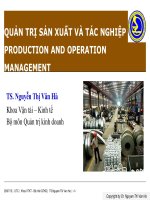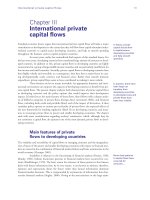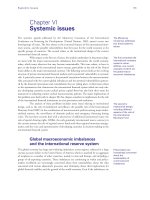- Trang chủ >>
- Đề thi >>
- Đề thi lớp 6
Chapter 9
Bạn đang xem bản rút gọn của tài liệu. Xem và tải ngay bản đầy đủ của tài liệu tại đây (337.97 KB, 20 trang )
<span class='text_page_counter'>(1)</span><div class='page_container' data-page=1>
MANAGERIAL ECONOMICS
MANAGERIAL ECONOMICS
12
12
ththEdition
<sub> Edition</sub>
By
By
</div>
<span class='text_page_counter'>(2)</span><div class='page_container' data-page=2>
Linear Programming
Linear Programming
</div>
<span class='text_page_counter'>(3)</span><div class='page_container' data-page=3>
Chapter 9
Chapter 9
OVERVIEW
OVERVIEW
Basic Assumptions
Production Planning for a Single Product
Production Planning for Multiple Products
Graphic Specification and Solution
Algebraic Specification and Solution
Dual in Linear Programming
Dual Specification
</div>
<span class='text_page_counter'>(4)</span><div class='page_container' data-page=4>
Chapter 9
Chapter 9
KEY CONCEPTS
KEY CONCEPTS
linear programming
optimal solution
relative distance
method
feasible space
objective function
corner point
slack variables
simplex solution
method
primal
dual
</div>
<span class='text_page_counter'>(5)</span><div class='page_container' data-page=5>
Basic Assumptions
Inequality Constraints
Resource constraints limit usage to ≤ some
fixed amount.
Output quantity or quality constraints limit
production to ≥ some fixed amount.
Linear Assumptions
Constant output prices.
Constant input prices.
</div>
<span class='text_page_counter'>(6)</span><div class='page_container' data-page=6>
Production Planning for a Single
Product
Production Processes
Equal distances along the same process ray indicate
equal output quantities.
Equal distances along different process rays indicate
different output quantities.
Production Isoquants
Linear segments represent input combinations used
to produce a given level of output.
Least-cost input combination is on feasible isocost
line closest to origin.
Maximum output with limited resources is on feasible
</div>
<span class='text_page_counter'>(7)</span><div class='page_container' data-page=7></div>
<span class='text_page_counter'>(8)</span><div class='page_container' data-page=8></div>
<span class='text_page_counter'>(9)</span><div class='page_container' data-page=9></div>
<span class='text_page_counter'>(10)</span><div class='page_container' data-page=10></div>
<span class='text_page_counter'>(11)</span><div class='page_container' data-page=11>
Production Planning for Multiple
Products
Objective Function Specification
Maximize profits, revenue or quantity subject to ≤
resource constraints.
Minimize cost subject to ≥ output constraints.
Constraint Equation Specification
Resource use cannot exceed availability.
Output quantity/quality constraints must be met.
Nonegativity Requirement
</div>
<span class='text_page_counter'>(12)</span><div class='page_container' data-page=12>
Graphic Specification and Solution
Solving the LP Problem
Analytic expression is the first step.
Graphic representation builds intuition.
Graphing the LP Problem
The LP feasible space graph shows
possibilities.
The LP objective function depicts most
</div>
<span class='text_page_counter'>(13)</span><div class='page_container' data-page=13></div>
<span class='text_page_counter'>(14)</span><div class='page_container' data-page=14></div>
<span class='text_page_counter'>(15)</span><div class='page_container' data-page=15></div>
<span class='text_page_counter'>(16)</span><div class='page_container' data-page=16></div>
<span class='text_page_counter'>(17)</span><div class='page_container' data-page=17>
Algebraic Specification and
Solution
Slack Variables
Slack variables convert ≥ or ≤ constraints into equalities.
Zero slack implies full employment.
Positive slack implies excess capacity.
Algebraic Solution
Corner point with highest value is maximum.
Corner point with lowest value is minimum.
Slack Variables at the Solution Point
Binding constraints imply no slack.
Nonbinding constraints imply slack.
Computer-based solution methods work best for
</div>
<span class='text_page_counter'>(18)</span><div class='page_container' data-page=18></div>
<span class='text_page_counter'>(19)</span><div class='page_container' data-page=19>
Dual in Linear Programming
Duality Concept
Pairs of symmetrical LP problems are called
the primal and dual.
Every primal has a dual and
<i>vice versa</i>
.
Primal and dual solutions are related.
Shadow Prices
Shadow prices are opportunity costs.
Remember: costs of constrained resources
</div>
<span class='text_page_counter'>(20)</span><div class='page_container' data-page=20>
Dual Specification and Solution
Dual Objective Function
Dual of profit maximization problem seeks minimum
cost solution.
Dual of minimum cost problem seeks highest
production value given resource constraints.
Dual Constraints
Binding constraints imply no slack.
Nonbinding constraints imply slack.
Dual Slack Variables
</div>
<!--links-->









